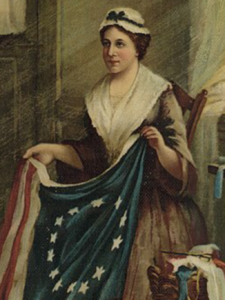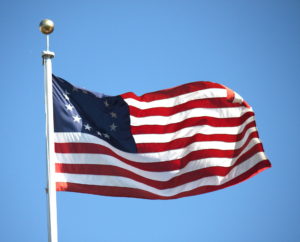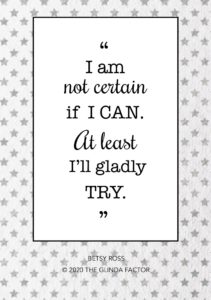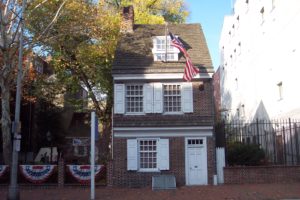
Passionate Patriot
She was born on the first day of the first month of the first year of the new calendar. This auspicious beginning foretold a life of unique accomplishments, hardships, and immortality as an American legend. Return to 1776 and meet Betsy Ross…
Her Ruby Shoe Moment
The Power of the Wand
Her Yellow Brick Road
Brains, Heart & Courage
Glinda’s Gallery
Just the Facts
Her Ruby Shoe Moment
Betsy Ross looked up as the door to her Philadelphia upholstery shop opened and three men walked through it. One was her late husband’s uncle, Colonel George Ross, who was a member of the Continental Congress. Betsy knew the other two men from church: Congressman Robert Morris and Colonel (soon to be General) George Washington, who had taken charge of the Revolutionary Army. She knew Washington particularly well, as he had commissioned items from her shop for his home and wardrobe before.

Betsy painted in 1893 by Charles Weisgerber (Wikimedia Commons)
It was June 1776, and the city was abuzz with activity. Philadelphia was hosting the Continental Congress, so was the center of the ongoing Congressional conversation about whether to formally declare independence from England.
The men told Betsy that they were members of a committee appointed by Congress to design a new flag for the united colonies. While each colony had its own flag, there wasn’t one that represented the union. They asked Betsy if she could make a flag for them. Her reply was honest: she had never made one before, so she didn’t know if she could, but was willing to try. She did assure them that “if the pattern were shown to her she had not doubt of her ability to do it.”
Betsy invited them into her back parlor to get more details. Washington showed her his sketch of his idea: thirteen red and white stripes with thirteen six-pointed stars. Betsy liked the idea, but also had some suggestions based on her flair for design. First, that the flag be a rectangle instead of a square. Second, that the stars have five points, because they would be easier to make, and therefore look better. She convinced them by folding a piece of paper into triangles and making one cut for a perfect star. Third, that the stars not be scattered around the flag, but instead organized in straight lines or a circle.

Betsy’s flag (Wikimedia Commons)
The men were persuaded. Washington sat at her parlor table to make another drawing that incorporated Betsy’s changes. They men left her shop and gave the new sketch to a local painter, whose job was to add color to the committee’s proposed designs. They then sent word to Betsy, asking her to visit a ship’s merchant down at the wharf. He gave her the finished stars and stripes design and loaned her a flag she could study to see how they were sewn to ensure strength and elasticity, two very important qualities of a flag that would lead soldiers in battle.
Betsy worked hard and quickly on the flag, as Congress debating whether to declare independence from England. Once she gave her finished product to the committee, it was raised on the mast of a committee member’s ship at the wharf with the other designs under consideration. Betsy’s flag was the unanimous choice of both the committee and members of the public who had gathered to see what was going on.
Uncle George showed up at Betsy’s shop the next day to tell her that Congress had approved and adopted the stars and stripes as the official flag of the union. He asked her to make as many of the flags as she could as fast as she could, giving her a 100 pound banknote to buy the initial supplies. It was the start of a new source of business for Betsy, as for the next 50 years, she made flags for the government.
The Power of the Wand
Some historians have challenged whether Betsy made the first flag because there is no “official documentation” like an order or invoice for the flag from Betsy’s shop. The first mention of the flag in the Congressional Record is June 14, 1777, when Congress declared it the official flag of the United States of America.
But it is important to remember that history is not only records and proclamations, but is also recorded as stories are handed down and documented from one generation to the next. Betsy shared her story with her daughters, niece, and grandchildren. Her grandson, William Canby, presented it to the Historical Society of Pennsylvania in 1870, and Betsy’s daughter, niece, and granddaughter provided notarized affidavits of their recollections.
Learn more about oral history, where historians collect and record people’s stories and memories, at www.oralhistory.org. Arts Educator and Writer Laurie Lathem is currently collecting stories for an oral history project called “Ghost Mode – Teens in the Pandemic” Learn more at www.laurielathem.com.
Her Yellow Brick Road
When Betsy was 12, she became an apprentice at an upholstery shop. Upholsterers in Betsy’s day were some of the busiest tradespeople. They covered furniture and made curtains, wall coverings, bedding, and clothing. Anything that involved fabric, a needle and thread was within their scope of expertise. Philadelphia was a wonderful place to operate an upholstery business. It was the biggest city in the colony with the wealthiest residents, who all wanted their houses to reflect their status.
As an apprentice learning the trade, Betsy started at the bottom and had to work her way up. Her first tasks included running supplies from storage to the sewers and back again, ironing fabrics, and cleaning the shop. She eventually was trusted to work with the fabrics, including laying out patterns, cutting cloth, and doing the initial loose stitching called basting. Her neat stiches and eye for design finally earned her the opportunity to do the precise stitching and embroidery that turned fabric into a beautiful end product.
 Betsy loved working at the shop, and every night went home and told her Great Aunt Sarah about the projects she was doing. Great Aunt Sarah lived with Betsy’s family, but in her prime had been an independent woman who had started her own seamstress and cider businesses. Betsy adored her and had spent hours with her when she was younger learning how to sew.
Betsy loved working at the shop, and every night went home and told her Great Aunt Sarah about the projects she was doing. Great Aunt Sarah lived with Betsy’s family, but in her prime had been an independent woman who had started her own seamstress and cider businesses. Betsy adored her and had spent hours with her when she was younger learning how to sew.
One of Betsy’s fellow apprentices was John Ross, and as the years passed, the two fell in love. Betsy’s parents disapproved of John because he wasn’t a Quaker, and Quakers who married outside the religion had to leave the church. John asked Betsy to marry him, but Betsy was torn between her love for him and her family’s wishes.
John opened his own upholstery shop in early 1773, around the same time that Great Aunt Sarah died. Sarah had always told Betsy to make her own decisions, and inspired by her aunt’s legacy, Betsy decided to follow her heart. She and John eloped on November 4, 1773. Although Betsy was no longer allowed to attend Quaker services, she filled her time working with John at the shop. The Quakers asked her to apologize for her marriage and she refused because she wasn’t sorry.

Betsy Ross House on Arch Street in Philadelphia, where she opened her upholstery shop (Wikimedia Commons).
Betsy and John were very skilled and their business grew quickly. Philadelphia had become the center of the debates over seeking independence from England, which brought even more important and wealthy people into town. George Washington hired them to make bed hangings for him when he was there for the First Continental Congress in 1774!
As war grew closer, the colonial regiments needed tents, sleeping bags, and flags. John joined the local militia and died in an accident while on duty in early 1776. After he died, Betsy’s relatives convinced her to sell the shop to pay off its creditors and return to her parents’ home. She did, but soon regretted it. Inspired by the memory of Great Aunt Sarah, she opened up her own shop, which she called “Elizabeth Ross, Upholsterer” a few months later.
Brains, Heart & Courage
Elizabeth “Betsy” Griscom was born during one of the harshest winters New Jersey had seen in years, with deep snow and scarce food and supplies. Even more auspiciously, Betsy was born on the “first day of first month of first year of the new calendar.” For centuries, the first day of the new year was March 25, but starting in 1752, the calendar was changed to start the year on January 1 instead. And on that day, Betsy was born into her big Quaker family. She was the 8th of 17 children, although only nine survived into adulthood.
Betsy’s dad, Samuel, was a carpenter who moved the family to Philadelphia when Betsy was only three. Philadelphia was quickly turning into a center of industry and there was lots of work for him there. Betsy’s grandparents had immigrated to the colonies looking for religious freedom as Quakers, and their religion was very important to both Samuel and Betsy’s mom, Rebecca.

1952 Stamp Commemorating Betsy’s 200th Birthday (Wikimedia Commons).
Quakers attended two weekly church services and devoted themselves to a culture of hard work and modesty. They were not allowed to play or listen to music, dance, read fiction, play cards, or go to the theater. Instead, approved entertainment centered around outdoor activities like hayrides, picnics, and ice skating. Quakers believed in educating girls the same as boys. Betsy went to the Friends Public School for Quakers 6 days a week, 8 hours a day, where she worked hard at her lessons and spent her free time sewing quilts and baby clothes.
When she was 12, Betsy visited her older sisters at work at William Webster’s upholstery shop. While she was there, Betsy noticed one of the workers struggling with a project and was able to help her fix it. Mr. Webster noticed her skill and asked if she wanted to be an apprentice. She said yes, so long as her parents agreed. They gave permission, and Betsy left school to learn the upholstery trade.
Glinda’s Gallery
Just the Facts
- Betsy married Joseph Ashburn on June 15, 1777 and had two daughters, one of whom died before her first birthday. Joseph was a crewmember on an American ship which was captured by the British in 1781. The crew was charged with treason and imprisoned in England. Joseph died there on March 3, 1782.
- Joseph’s friend John Claypoole survived and traveled to Philadelphia to tell Betsy the sad news. Their new friendship turned to love and they got married on May 8, 1783. The two of them had four more daughters, one of whom died young.
- John began working with Betsy at the upholstery shop. As a former sailor, he was a good contact for all the needs ships had. John became a customs inspector in 1794, but suffered a stroke in 1800 that left him unable to work. Betsy took on the support of the entire household, and John died in 1817.
- Betsy’s parents and sister died of yellow fever in 1793, and Betsy took in her orphaned niece to raise. In 1812, Betsy’s daughter Clarissa lost her husband and she and her six children moved in with Betsy. Clarissa worked with Betsy, and when Betsy retired at age 76, Clarissa took over the shop.
- Betsy’s eyesight began to falter, and she was completely blind by age 81. She died in her sleep on January 30, 1836 at age 84.
- The U.S. Postal Service issued a Betsy Ross stamp on January 2, 1952 to honor her 200th birthday.
- According to legend, George Washington interpreted the elements of the flag this way: the stars were taken from the sky, the red from the British colors, and the white stripes signified the secession from the home country. The stars were in a circle so that no one colony would be viewed above another. It is reported that George Washington said, “Let the 13 stars in a circle stand as a new constellation in the heavens.”
- In 1782, the Congress chose the colors of the flag for the Great Seal of the United States and listed their meaning as: Red: valor and hardiness; White: purity and innocence; and Blue: vigilance, perseverance, and justice.
Want to Know More?
Canby, William (Betsy Ross’s grandson). The History of the Flag of the United States: A Paper read before the Historical Society of Pennsylvania (March 1870).
Affidavit of Sophia B. Hildebrant, Daughter of Clarissa S. Wilson and Granddaughter of Elizabeth Claypoole (Betsy Ross) (May 27, 1870).
Affidavit of Margaret Donaldson Boggs, Daughter of Sarah Donaldson, who was a Sister of Elizabeth Claypoole (Betsy Ross) (June 3, 1870).Affidavit of Rachel Fletcher, a daughter of Elizabeth Claypoole (Betsy Ross) (July 31, 1871).
Buckley, Jr., Jim. Who Was Betsy Ross (Penguin 2014)
Miller, Marla R. Betsy Ross and the Making of America (Henry Holt & Co. 2010).
St. George, Judith. Betsy Ross, Patriot of Philadelphia (Henry Holt & Co 1997).
Alexander, Kerri Lee. “Betsy Ross 1752-1836” (National Women’s History Museum 2018-19)
Betsy Ross & The American Flag FAQ (USHistory.org)
Betsy Ross House (HistoricPhiladelphia.org)
